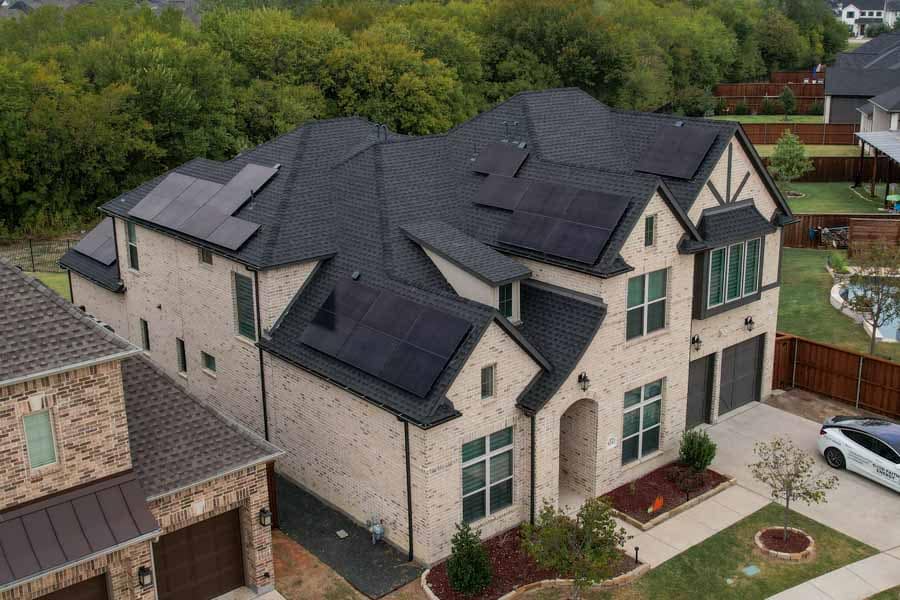The best types of roofs for solar panels are asphalt shingles, metal, tile, and flat roofs. They offer durability, compatibility, and efficiency for solar installations, with factors like orientation, tilt, and lifespan playing crucial roles in maximizing energy production.
Solar panels are a great investment in clean energy, reducing electricity costs and lowering your carbon footprint. In this blog post, we’ll explore the best types of roofs for solar panels, factors to consider, and how Good Faith Energy and GFE Roofing can make your solar journey seamless.
Table of contents
Why Does Roof Type Matter for Solar Panels?
Your roof is the foundation of your solar energy system. Its characteristics influence:
- Installation ease: Certain roof types require specialized equipment or methods, impacting cost and time.
- Energy efficiency: The slope and orientation affect how much sunlight your solar panels capture.
- Durability: Ideally, your roof should last as long as your solar panels, which typically have a lifespan of 25-30 years.
Top Roof Types for Solar Panel Installation
1. Asphalt Shingle Roofs

Why they’re ideal:
Asphalt shingles are the most common roofing material in the U.S. Their affordability and adaptability make them a popular choice for solar installations.
- Simple installation: Mounting systems easily attach to shingles.
- Cost-effective: Asphalt shingles are budget-friendly, reducing the overall expense of the project.
- Durable lifespan: Most last 20-30 years, aligning with solar panel systems.
Drawbacks:
- They may degrade faster in extremely hot climates.
2. Metal Roofs

Why they’re ideal:
Metal roofs, especially standing seam designs, are excellent for solar panel mounting.
- Integrated installation: Panels can be clamped directly to the seams without drilling.
- Longevity: Metal roofs last 40-70 years, meaning no need for roof replacement during the life of your solar panels.
- Eco-friendly: Many metal roofs are recyclable, complementing solar energy’s green benefits.
Drawbacks:
- Higher upfront cost for the roof material.
3. Tile Roofs (Clay, Concrete, or Slate)

Why they’re ideal:
Tile roofs provide durability and natural insulation, making them effective for energy-efficient homes.
- Longevity: These roofs often last 50+ years.
- Aesthetic appeal: Panels blend well with tiles for a cohesive look.
Drawbacks:
- Fragile tiles require careful handling during installation, increasing labor costs.
4. Flat Roofs

Why they’re ideal:
Flat roofs, common in commercial and some residential buildings, offer unique flexibility for solar installations.
- Custom angles: Racking systems can tilt panels for optimal sun exposure.
- Easy access: Maintenance and cleaning are simpler on flat surfaces.
Drawbacks:
- Potential drainage issues that may require additional design considerations.
Roofing and Solar Integration with Good Faith Energy and GFE Roofing
One of the biggest concerns for homeowners considering solar is the condition of their roof. If your roof is nearing the end of its lifespan or requires repairs, solar installation could be delayed.
That’s where GFE Roofing, the roofing division of Good Faith Energy, comes in. We provide:
- Roof replacements and repairs: Ensuring your roof is in top condition before solar installation.
- Seamless integration: As experts in both roofing and solar, we coordinate the process to save you time and hassle.
- Matching lifespans: By replacing your roof and installing solar panels together, you’ll avoid costly future disruptions.
GFE Roofing and Good Faith Energy are the perfect match, offering a one-stop solution for your roofing and solar needs.
Factors to Consider Beyond Roof Type
1. Roof Orientation and Tilt
- South-facing roofs in the northern hemisphere maximize sunlight exposure.
- A tilt angle of 15-40 degrees is generally optimal for energy production.
2. Roof Condition
If your roof needs replacement, address it before installing solar panels. This ensures you won’t have to uninstall and reinstall panels later.
3. Shade and Obstructions
Ensure your roof isn’t heavily shaded by trees or nearby buildings, as this can significantly reduce energy output.
4. Local Climate
Different roof types perform better in different climates. For example:
- Metal roofs are ideal in snowy regions due to their durability and snow-shedding capabilities.
- Tile roofs excel in hot, sunny areas by providing natural insulation.
Can Solar Panels Work on Any Roof?
While most roofs are compatible with solar panels, some types, like wood shakes or thatched roofs, present challenges. For such cases, consider ground-mounted systems as an alternative.
Good Faith Energy and GFE Roofing: Your Solar and Roofing Experts

With Good Faith Energy and GFE Roofing, you get a comprehensive solution for all your roofing and solar needs. We:
- Evaluate your roof to ensure it’s solar-ready.
- Offer roof replacement services through GFE Roofing, aligning your roof’s lifespan with your solar system.
- Provide expert installation for maximum energy efficiency and durability.
Our team handles everything, from roof inspections to solar system design, ensuring a stress-free experience.
Conclusion
The best roof for solar panels depends on material, condition, orientation, and climate. Asphalt shingles, metal roofs, tile roofs, and flat roofs all have unique benefits. If your roof isn’t ready for solar, GFE Roofing can replace or repair it, making it the perfect match for your solar energy project.
With the right planning and expert help, solar energy is within reach. Contact Good Faith Energy today to schedule a consultation and take the first step toward sustainable energy and a durable roof.